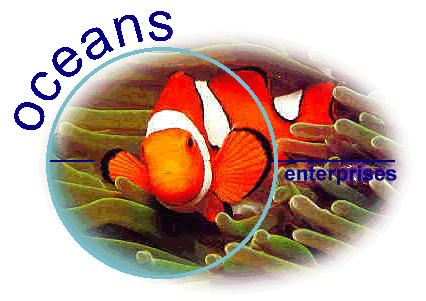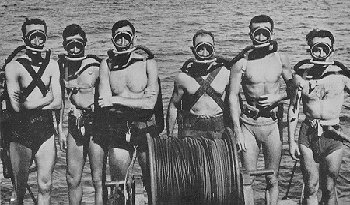| Sponsored by:
OCEANS ENTERPRISES Publishers & Distributors |
 |
| CLASSIC DIVE BOOKS
Author Philippe Tailliez. |
HOMEPAGE |
| It is with great sadness
that we report the passing of Capitane Philippe Tailliez, on Thursday September
26, 2002, in Toulon, France. He was ninety-seven years of age. A diver
since the 1930s, it was Tailliez who introduced Jacques Yves Cousteau to
the sport of goggle fishing in 1936. Two years later he introduced Cousteau
to Frederic Dumas and together the diving trio became the famed "Les Mousqemers"
of the French Mediterranean coast.
Philippe Tailliez was a career Naval officer, and in 1945 he became the first commanding officer of the Group "Etudes et de Recherches Sous-Marines G.E.R.S." This was the first military group to employ the Cousteau-Gagnan Aqua-Lung and in 1949, under Tailliez's command, it produced the book "Plongee en Scaphandre". This book was the worlds first diving manual to cover the use of the Aqua-Lung and included repeat dive tables developed by G.E.R.S. It was later revised and translated into English. His 1954 book Plongees sans Cable recorded his early diving adventures and was published in English with the title To Hidden Depths. His involvement with diving and the sea continued throughout the last half of this century. Capitaine Tailliez was the recipient of the Historic Diving Society's 1998 Historical Diver Magazine Pioneer Award, and he received numerous other international awards during his long and distinguished career. (Report courtesy Stephan Aldebert, France, and Sam Miller, USA.) BOOKS by Philippe Tailliez PLONGES SANS CABLES
NOUVELLES PLONGES SAN
CABLES
|
||||||
It is of course predominantly biographical, commencing with Tailliez as a young Naval officer diving with Jacques Cousteau in 1937.They had meet on the cruiser Condorcet where Cousteau was a midshipman. Cousteau had only recently recovered from a terrible motor accident in which he ‘held out against the surgeons' who wanted to amputate his arm. Had they done so, the course of history would have changed dramatically; the exploration of the underwater world would not have developed the way it did. Although not strong on equipment, Tailiez gives us a glimpse of the embryonic equipment we now use today. It would appear that the development of the rubber ‘foot-fins' came from the commander of the cruiser, Captain de Corlieu in 1924. "Divers who without this royal gift would still have to shuffle about under the sea may honour him. We made our own fins, sandwiching saw-blades between two slices of rubber cunningly glued together." Primitive goggles gave them the ability to see underwater. "We felt a secret contempt for the bathers without goggles, decapitated by the water, kicking about like huge cats suspended by the scruffs of their necks." He speaks of his frustration and wonder at not being able to breath through a snorkel of several feet in length - "all our efforts to inhale were futile", and of the realisation that "the lungs of a swimmer, which acts as a buoy in keeping him on the surface, decreases for the skindiver .... in proportion to the depth and presure of the water". Their idol was Commander Le Prieur, "who in 1924 had blazed the trial of undersea exploration in idependent diving gear", but unfortunately does not expand on these pioneering exploits. He admires William Beebe, "one of the greatest divers of all times, who had been the first, in 1932-4, to risk an enormous vertical plunge". And Guy Gilpatrick "who from 1934 onwards impaled fish with fencing lunges on the shores of the Riviera. The Swiss diver Jacques Grob is not exactly a household name, but he was one of the early divers who accompanied Tailiez and Dumas on many dives. The war did not curtail
the diving exploits of Tailliez even though he was literally laid out by
a shipboard accident for several months. It gave Cousteau the opportunity
to shoot his first feature film, Par dix-huit metres de fond (Nine Fathoms
Down) and later, Sunken Ships - "at a cost of a few hundred
hours spent on nine ships lying at the bottom between Marseilles and Cavalaire".
Tailliez does not, unfortunately, describe the equipment used, but no doubt
consisted of triple tanks of about 27 cf, and the regulator constructed
by Emile Gagnin and Cousteau. Jean Latour joined Tailliez briefly,
and later made a name for himself as an exceptional author.
Cousteau, Tailliez and Dumas offered their expertise as divers and with Navy sanction, established a formidable team in 1944. The first assignment for the Undersea Research Group was the removal of two torpedoes from a scuttled German submarine off the Saint-Mandrier peninsula, arguably the first underwater demolition team using scuba. The dangerous task of mine recovery and detonation consumed much of their time ... "Cousteau, for the benefit of the experts, filmed the mines from every angle - but keeping his disatnce - Dumas and I prowled around, full of interest..." Of greater interest no doubt was their observation of submarine design which necessitated being in the water at the time ..." we could hear the dull rumble coming nearer and nearer and yet did not know in which direction to turn. At last her stem, fine and dark, with its saw-toothed net-cutting device, cam straight at us." Cousteau even filmed the firing of a torpedo, included in a documentary film called Une Plongee du Rubis (Rubis being the name of the submarine). Tailliez speaks of the sponge-diver Catsulianis and his terrifying ordeals (he later became a helmet diver), leading into a description of the attempt at deep diving beyond the three hundred foot mark by Chief Petty Officer Fargues, one of the Underwater Group - he didn't make it; at four hundred feet he signed his initials on the slate and lost unconsciousness . "In the history of aqualung diving he was the first victim." Such was the success of the Undersea Group that the French Navy provided a ship to improve mobility. The Elie-Monnier became Cousteau's first command, with Tailliez continuing overall charge of the Group. Tailliez claims, with no dispute, that "The Group has given the aqualung diver the rules governing his safety and his technique, in fact a whole doctrine." We know of the development of the regulator, but the Group also invented other life-saving equipment (the Alinat life-saving belt, and the Dumas buoy), and trained hundred of divers, most to pass on their knowledge to those using ‘free-diving' equipment for military, commercial or pleasure use. In 1946 the Group explored the Fountain of Vaucluse, a freshwater grotto, and it is here that we read of ‘breathing cylinders' bring filled to 3,000. Dumas and Cousteau came close to losing their lives. The initial most significant ‘archaeological' find was that of the ‘Mahdia galley', off Cape Africa. Tipped off as to the whereabouts of the wreck by Greek sponge divers; "These arduous excavations resulted in the discovery of many bronzes, busts, statues, ‘craters' of wine-bowls, candelabras, and some remains of the hulk and rigging of an ancient galley. These pieces were collected together nd laced in five rooms specially built for them in the Alaoui Museum in Tunis, where they can still be seen". The extensive chapter ‘Descent of Professor Piccard's Bathyscaphe' provides an insight into the work of Piccard and Beebe. Cousteau's team - as no doubt it had now become - joined the historic Piccard expedition in 1948. Tailliez left the Group in 1950, and given the command of a French ship, but this did not curtail his diving exploits. Cousteau had already left the Group in 1949, to equip his new oceanographic vessel Calypso. Cousteau and Dumas no longer figure in his diving, as Tailliez dives on treasure ships in Indo-China. Tailliez also tells of military salvage in the Mekong as the Viet Minh become more than just a nuisance. Operations in Indo-China would interest anyone intersted in Vietnam and the all-out war that resulted when the French pulled out. Cousteau was replaced by Lieutenant Georges de Vaisseau Houot as commander of the Elie-Monnier. A polio victim, now in recovery, he was forbidden to bathe (why, I have no idea), and thus could not dive. He later volunteered for a bathyscaphe project being developed in the Toulon Naval Dockyard. In August 1943, he decended to the record depth of 13,287 ft with Pierre Willm. "The bathyscaphe, free of any cable, will evolve like every other mechancical invention, becoming more and more closely adapted to its submarine purpose." And so it was to be. Readability: easy style,
a bit disjointed at times as there is no strict chronological order.
READER COMMENT. Abel Domenech, an experienced
diver of many decades from Argentina, writes:
|

